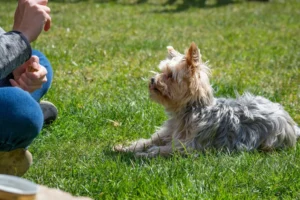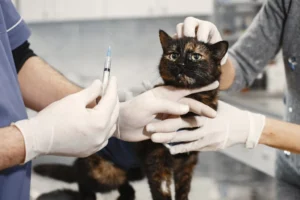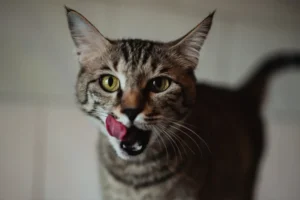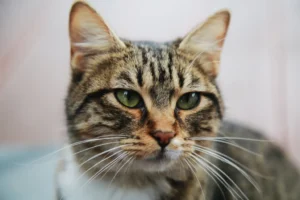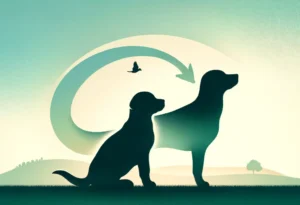We’ve all been there – you’re standing in the pet food aisle, baffled by the endless choices, and you know your feline overlord at home is picky with a capital P. But here you are, needing to switch up Mr. Whiskers’ menu for health, life stage, or even the dreaded vet’s orders.
In this blog post, you’ll find actionable, no-nonsense advice to make the diet transition as smooth as possible for your furry friend (and for you).
Key takeaways:
- Gradually mix new food into the old, starting with a 75/25 (old/new) ratio and moving towards 100% new food over 10 days to prevent digestive upset.
- Monitor your cat’s response to the diet change by observing appetite, bowel movements, and coat condition, and adjust the pace as needed.
- Employ tricks like adding food toppers, warming up meals, and maintaining a consistent feeding schedule if your cat resists the new food.
Why Can’t I Just Switch My Cat’s Food Overnight?
Swapping your cat’s chow abruptly is like expecting someone to switch from a lifelong diet of pizza to salads in a single day—both unrealistic and a recipe for an unhappy tummy.
Cats have a digestive system that’s quite particular and is known to throw a hissy fit if major changes occur without a proper introduction. A gradual transition protects your kitty from gastrointestinal upset, including symptoms like diarrhea or constipation, which can be both distressing for your cat and unpleasant for you to deal with.
Understand that your feline friend relies on a consistent balance of bacteria in their intestines to digest food properly. Tossing a curveball into their diet can disrupt this balance, causing your whiskered companion undue stress. That’s why taking it slow and steady wins the race when changing their menu.
What’s the Best Method to Transition My Cat to a New Diet?
Picture this: easing into a warm bath versus cannonballing into a cold pool. That’s the difference between a gentle versus sudden switch in your cat’s diet. Begin by mixing the new food with the old, allowing your cat to gradually adjust to the new flavors and textures. Here’s a simple, yet effective step-by-step guide to ensure a smooth transition:
- Days 1-3: Serve a blend that contains roughly 75% of the old food and 25% of the new diet.
- Days 4-6: Level up the mix to an even 50/50 split between the old and new food.
- Days 7-9: Shift the balance in favor of the new grub, offering a combination of 75% new food and 25% old food.
- Day 10+: If there are no signs of discomfort, your cat is ready to dive into a bowl of 100% new food.
Remember, some cats may need a slower switch. You know your furry overlord best, so adjust the timeline as necessary, especially for picky eaters or those with sensitive stomachs. Misjudging the pace can lead to a food strike, and let’s face it, no one wants to negotiate with a hangry cat.
How Can I Tell If My Cat Is Taking Well to the New Diet?
Just like you get a spring in your step from a nourishing meal, your cat too will show signs of a successful transition.
A healthy appetite, consistent eating habits, and normal bowel movements are the trifecta indicating the new diet is hitting the spot. Keep an eye on their energy levels; a content cat is often an active cat.
But, be on the lookout for red flags such as vomiting, diarrhea, or a turned-up nose at meal times. These may signal that your cat isn’t jiving with the new cuisine or that you might be moving too fast through the transition stages. Should these issues persist, don’t play a game of cat and mouse with their health—consult your veterinarian.
Monitoring for these reactions is vital, but here’s a unique tip: observe your cat’s coat. A shiny and smooth coat can be indicative of a well-received diet, rich in essential nutrients. If your cat’s fur appears duller or more brittle, it may warrant a closer inspection of their dietary needs and a chat with your vet.
Keeping tabs on your cat’s diet isn’t just about watching what they eat; it’s tuning into their overall well-being. By mindfully transitioning their food and paying attention to the verbal and non-verbal feedback they provide, you’re ensuring the nine lives they’re rumored to have are as happy and healthy as possible. Stay tuned for more insights on keeping your feline at the top of their game!
What If My Cat Just Won’t Eat the New Food?
Hey there, fellow cat aficionado! So, you’re trying to switch your kitty to a new diet, but they’re turning up their nose at it? That’s purr-fectly normal – cats can be picky eaters. But don’t fret; let’s outsmart those finicky feline instincts with some clever tricks.
-
Mix old with new: Gradually introduce the new food by mixing it with the old grub. With each meal, increase the ratio of new to old until you’ve made a complete switch.
-
Entice with Toppers: Sometimes, a sprinkle of bonito flakes or a drizzle of tuna juice can make all the difference. It’s like the cherry on top for our whiskered friends.
-
Warm It Up: Just like us, some cats prefer their dinner warm. Heating the food can release tempting aromas and make it more palatable.
-
Create a Routine: Cats love a predictable schedule. Feed them at the same time each day to create a comforting ritual around the new diet.
-
Slow and Steady: Patience is key. Offer the new food numerous times. A cat might need to see a food a few times before they decide to dive in.
If your kitty isn’t quite on board after giving these a go, don’t despair. It’s time to seek some expert advice. Reach out to your veterinarian or consider consulting a pet nutritionist. They’re the cat’s meow when it comes to understanding feline nutrition and can offer tailored strategies for stubborn cases.
Are There Special Considerations for Dietary Changes in Kittens or Senior Cats?
When it comes to our fluffy pals, age definitely matters. Kittens and senior cats have distinct dietary needs that are essential to consider when planning a diet change.
Kittens:
-
Grow, Kitty, Grow: These little guys need more calories, proteins, and certain nutrients to help their bodies grow strong. So their new diet should be high-calorie and nutrient-rich to keep up with their zoomies.
-
More Frequent Feeding: Kittens do best with multiple small meals throughout the day, as opposed to the typical 1-2 meals for adult cats.
-
Consult the Experts: Always involve your vet when changing a kitten’s diet. They’ll ensure that your mini-meower gets all the nutrients needed for a healthy start in life.
Senior Cats:
-
Tailored Nutrition: As cats age, their metabolism slows down, and they may need a diet with fewer calories but more fiber and specific nutrients to support joint health and kidney function.
-
Monitoring Health: With old age come health issues. A diet change should be monitored by your vet to make sure it’s supporting your senior cat’s well-being, not causing additional stress.
-
Patience and Persistence: Older cats might be set in their ways, making dietary changes even more challenging. Patience and gentle persistence are key. And remember, never change a senior cat’s diet abruptly.
Here’s a unique nugget most folks overlook: Hydration is critical, especially for seniors. Many cats don’t drink enough water, and dehydration can be a real concern. Wet food or adding water to kibble can help your older cat stay hydrated, which is crucial for their overall health and can ease the dietary transition.
Remember, consulting your vet is paramount, whether dealing with a bouncy kitten or a dignified senior. They’re the experts when it comes to the nitty-gritty of feline nutrition through all nine lives.
Transitioning your cat to a new diet can be like herding… well, you know. But with the right steps and some expert backup, it’ll be smooth sailing. And remember, every cat is unique, so what works for one may not work for another. Keep an eye on your furball, and with a dash of patience, you’ll find the purr-fect diet that keeps them happy and healthy.
Alex, a passionate animal lover, has experience in training and understanding animal behavior. As a proud pet parent to two dogs and three cats, he founded AnimalReport.net to share insights from animal experts and expand his knowledge of the animal kingdom.




